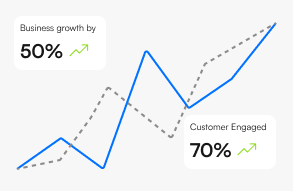Conversational Banking: The Next Frontier of Innovation in the Finance Sector

Namrata Chakraborty
March 11, 2024
13 min

Table of Contents
Fact Check
- Chat banking, also known as conversational banking, refers to the use of natural language processing (NLP) and artificial intelligence (AI) technologies to enable customers to interact with their bank digitally through various chat interfaces like chatbots on websites and mobile apps or Siri-like voice assistants. It allows banking customers to perform various financial tasks, such as checking balances, transferring funds, and getting account information, or troubleshooting digital financial activities using simple conversational language.
- Artificial intelligence can be used in digital banking for customer support, fraud detection, personalized account management, lead generation, and personal selling of financial services.
- Bank of America’s Erica, RBC's NOMI, and DBS Bank’s digibot are some successful examples of conversational AI that help customers manage personal finance, complete transactions, and offer financial advice.
- Emerging trends like voice commerce, hyper-personalized conversations, emotional intelligence in bots, and IoT device integration will shape the future of conversational banking.
In the age where time is currency and convenience reigns supreme, the banking industry is undergoing a dramatic reinvention: seamless conversations with banks, where customer queries are met with instant responses, and financial advice is just a chat away. This transformation is fueled by the emergence of conversational AI in the banking sector.
From virtual assistants that feel like your personal financial concierge to chatbots that can handle your transactions reliably, conversational AI is turning banking interactions into intuitive dialogues, redefining what it means to bank in the digital age.
One reason behind the rapid adoption of conversational AI is that the advanced technology is becoming largely accessible. Building a chatbot has become easier than ever, with user-friendly code-free ai chatbot makers that require little to no coding knowledge. This accessibility democratizes the use of conversational AI, enabling banks of all sizes to leverage its benefits and provide enhanced services to their customers.
Understanding Conversational Banking: The Role of AI in the Finance Sector
Conversational banking or chat banking refers to the use of artificial intelligence (AI) technologies, such as natural language processing (NLP) and machine learning (ML), to facilitate interactions between customers and banking institutions through conversational interfaces like chatbots or voice assistants.
Unlike traditional banking methods that often involve navigating through complex menus or waiting on hold for assistance, conversational AI interfaces offer a more intuitive and seamless approach.
A fantastic example of conversational AI is Bank of America’s virtual assistant, Erica. Erica is capable of understanding and responding to human language naturally. This remarkable capability is powered by sophisticated natural language processing (NLP) algorithms.
Imagine a scenario where a customer called Sarah contacts Erica to inquire about her recent credit card transactions:
“Hi Erica, could you please help me review my recent credit card activity? I’m concerned about a few transactions that seem unfamiliar.”
Erica then formulates a response that not only acknowledges Sarah’s request but also offers reassurance and guidance:
“Of course, Sarah! Let me pull up your recent credit card transactions for review. I’ll highlight any transactions that appear unusual and provide additional insights to address your concerns. Please bear with me for a moment while I gather the necessary information.”
In this instance, Erica’s advanced natural language processing (NLP) algorithms spring into action. Despite the informal tone and specific request embedded within Sarah’s message, Erica effortlessly deciphers the intent behind Sarah’s inquiry.
Recognizing the keywords “recent credit card activity” and “unfamiliar transactions,” Erica swiftly retrieves Sarah’s transaction history and proceeds to analyze the relevant entries.
Through this exchange, Erica demonstrates her ability to navigate the nuances of human speech, understanding Sarah’s query within its broader context and responding in a manner that is both empathetic and informative.
By leveraging advanced NLP algorithms, Erica facilitates an instinctive and engaging interaction that replicates the fluidity of conversation between two individuals.
7 Important Use Cases of Conversational AI in Banking
Conversational AI in banking presents a win-win scenario for both finance-oriented corporations and their consumers.
It offers unparalleled convenience and personalized experiences for customers, enabling them to conduct banking activities effortlessly through ‘always available’ alternatives to human agents.
Meanwhile, for banks, conversational AI drives operational efficiency and cost savings by automating routine inquiries and transactions, resulting in improved customer service, enhanced loyalty, and a competitive edge in the market.
Here are some interesting use cases of Conversational AI in banking:
1. Customer Support

Conversational chatbots serving as the banking customers’ first point of contact can address a wide range of queries, including inquiries about account balances, loan eligibility, transaction history, interest rates, branch locations, online banking guidance, and more. Banking chatbots can handle a large volume of inquiries simultaneously, scaling to meet demand without compromising quality.
2. Account Management
Customers have a whole host of options when it comes to managing their bank accounts with Conversational AI. They can easily update their account information, such as contact details, mailing addresses, or preferred communication channels, by simply chatting with the banking bot.
Conversational AI also offers a sophisticated means for customers to navigate their transaction histories with ease, such as specific transactions within designated timeframes and categorize expenditures using nothing but natural language commands.
But it is not just about convenience; it is about customer empowerment. By harnessing advanced analytics capabilities of conversational AI, banking institutions can probe users’ spending patterns and behaviors to deliver personalized financial advice, including tailored budgeting suggestions, lucrative investment opportunities, or managing personal finance through spending alerts.
For instance, take a look at how Mastercard’s Kai banking platform uses conversational AI to help customers manage their personal finances:
Through this personalized assistance, customers gain a deeper understanding of their financial health and goals, setting the stage for informed decision-making and financial success.
3. Lead Generation and Lead Qualification
AI banking chatbots engage website visitors by asking qualifying questions to understand their needs and intentions. Based on responses, leads are categorized into hot, warm, or cold leads. Hot leads receive immediate assistance or account opening options or transfer to human agents, warm leads receive relevant resources, and cold leads are thanked for visiting.
The chatbot can integrate with the bank’s CRM systems to update lead profiles for prioritized follow-up efforts by the sales team, such as sending emails or scheduling calls.
4. Fraud Detection and Prevention
Based on a McKinsey and Company report, the majority of banking customers perceive the process of resolving financial fraud as both emotionally draining and extensive. Consequently, the report says, financial institutions that proactively assist customers in fraud detection and resolution are likely to have a higher trust score, brand loyalty, and advocacy.
Chatbots powered by conversational AI can detect and prevent banking fraud through real-time support and proactive surveillance. Some of the ways banking chatbots can help are ─
Monitor transactions in real-time and promptly alert customers about suspicious activities via chat, email, or push notifications, empowering them to act swiftly against potential fraud.
Verify transaction authenticity; for instance, if a customer receives a suspicious transaction notification, they can chat with the AI bot to confirm its legitimacy or potential fraud.
Analyze customer behavior and transaction histories to detect unusual activities.
5. Personal Selling, Cross-selling and Upselling
Based on market research conducted by Accenture, implementing strategies to cultivate deeper personal connections could allow banking institutions to potentially increase revenue from core customers by as much as 20%. Therefore, in this digital age, personal selling cannot be restricted to only face-to-face interactions with human agents. This is where the advanced natural-language processing power of conversation AI comes into play.
By seamlessly integrating sales into the natural conversational flow, chatbots can offer personalized product suggestions. For instance, if a customer frequently shops online, the AI might recommend a credit card with cashback rewards tailored to e-commerce purchases. AI-powered chatbots can also extract cross-selling or upselling opportunities from real-time conversations with customers by understanding their current needs and emotional state.
Consider the conversation below:
Michael: Hi there, I’m looking to apply for a credit card.
AI Chatbot: Great choice, Michael! Just a quick question before we proceed – have you recently applied for a mortgage with us?
Michael: Yes, I have.
AI Chatbot: Perfect! Since you’re already considering a credit card, I’d like to offer you the option to bundle your application with mortgage insurance for added peace of mind. It ensures your mortgage is covered in case of unforeseen circumstances like disability or death. Would you like to learn more about this option?
Michael: Sounds interesting. Can you give me a brief overview?
AI Chatbot: Absolutely! Mortgage insurance provides comprehensive protection for your home investment, ensuring your outstanding mortgage balance is paid off if something unexpected happens to you. It’s a smart way to safeguard your home and loved ones. Shall we add it to your credit card application?
Michael: Yes, let’s go ahead with that.
AI Chatbot: Wonderful! I’ll make sure to include mortgage insurance with your credit card application. Thanks for choosing us, Michael. If you have any other questions, feel free to ask!
In the above scenario, the chatbot leverages Michael’s recent mortgage application as a trigger to offer him an additional product, thereby maximizing the value of the customer relationship for the financial institution.
6. Gamified Banking Experience

Financial education remains a formidable challenge for banks, despite the critical importance of financial literacy in today’s world. With complex concepts such as budgeting, investing, and debt management, many individuals struggle to grasp these fundamentals, leading to poor financial decisions and outcomes.
Traditional methods of imparting financial knowledge often fall short in capturing users’ attention and sustaining their engagement. However, the emergence of gamification offers a promising solution to this dilemma.
Conversational banking offers users dynamic interactive quizzes or challenges customers to spur them towards specific goals or milestones. For instance, users may be presented with a challenge tailored to enhancing their understanding of emergency savings. With conversational AI, they receive personalized advice on setting up an emergency fund based on their income and expenses. As they make progress, such as consistently contributing to their emergency fund or reaching a specific savings goal, they earn rewards like virtual badges and points. Successful completion of the challenge might unlock perks such as waived fees on savings accounts or increased interest rates, motivating users to prioritize financial resilience.
7. Customer Feedback Analysis
AI-powered chatbots can be a great alternative to traditional methods of feedback collection, such as through forms, which often suffer from low response rates and limited depth of insight.
By interacting with customers in a conversational manner across various channels, including chats, social media, and surveys, chatbots eliminate the need for customers to fill out forms, making the feedback process more natural and effortless.
Thus, conversational AI enables banks to gather comprehensive insights directly from customers in real-time, facilitating the identification of trends, sentiments, and areas for improvement.
How is Conversation AI Used for Banking: Learning from Real-Life Success Stories
Some highly successful banks worldwide have been at the forefront of driving the rapid adoption of Conversational AI, recognizing the genuine potential of artificial intelligence in the realm of commercial banking. Here are some of the illustrious success stories:
1. DBS Bank’s digibank Virtual Assistant, ‘digibot’
DBS Bank, based in Singapore, implemented a virtual assistant named ‘digibot’ as part of its digibank initiative to revolutionize digital banking services. Digibot utilizes Conversational AI to offer personalized banking assistance and support to customers through the bank’s mobile app and website.
Customers can interact with digibot via voice commands or text input to perform various banking tasks, such as checking account balances, transferring funds, and scheduling payments.
By integrating Conversational AI into its digital platform, DBS Bank has streamlined customer interactions, reduced response times, and improved overall user experience. The implementation of digibot has contributed to increased customer satisfaction and loyalty, positioning DBS Bank as a leader in innovative banking solutions.
2. RBC’s NOMI
Royal Bank of Canada (RBC) introduced NOMI, an AI-powered conversational banking assistant, to provide personalized financial insights and recommendations to customers.
NOMI analyzes customers’ spending patterns, savings goals, and financial behaviors to offer tailored advice and suggestions for optimizing their finances.
Through the bank’s mobile app and online banking platform, customers can interact with NOMI to track expenses, set budget targets, and receive proactive alerts about potential savings opportunities.
RBC’s implementation of NOMI has contributed to increased engagement, improved financial literacy, and enhanced customer satisfaction.
10 Benefits of Using Conversational AI in the Banking Sector
Conversational banking offers benefits to both the customers and the financial institutions.
A. Benefits to Consumers
1. Convenience: Consumers can access banking services anytime, anywhere, without the need to visit a physical branch or wait on hold to speak with a customer service representative.
2. Speed: Conversational banking enables quick access to information and services. Queries can be resolved instantly, and transactions can be completed in a matter of seconds, reducing the time spent on traditional banking tasks.
3. Personalization: Virtual assistants can provide personalized recommendations and financial insights based on the user’s transaction history, spending patterns, and preferences. This enhances the overall user experience and fosters a sense of engagement with the bank.
4. Seamless Integration: Conversational banking platforms can seamlessly integrate with other digital services and platforms, such as e-commerce websites and mobile apps, enabling users to perform banking activities within the context of their daily digital interactions.
5. Language Flexibility: One of the biggest strengths of conversational AI in banking is language flexibility. It allows users to interact in their preferred language. This feature is particularly advantageous for individuals with disabilities or language barriers, ensuring inclusivity and accessibility for all.
B. Benefits to the Financial Organizations
1. Brand Differentiation: Offering advanced conversational banking capabilities, such as voice recognition, natural language processing, and predictive analytics, can differentiate financial institutions in the competitive marketplace and position them as leaders in digital innovation and customer experience.
2. Global Reach: Conversational banking transcends geographical boundaries, enabling financial institutions to cater to customers across different regions and time zones without the need for a physical branch presence, thereby expanding their market reach and customer base.
3. Partnership Opportunities: Conversational banking platforms can serve as a gateway for financial institutions to collaborate with third-party service providers, fintech companies, and other organizations. Through open APIs and integrations, banks can offer a broader range of services and solutions to customers, expanding their ecosystem and revenue streams while fostering innovation in the financial industry.
4.Customer Insights and Analytics: AI-powered chatbots or virtual assistants, generate extensive data on customer interactions, preferences, and behavior. These chatbot analytics inform product development, marketing strategies, and overall decision-making. For instance, if the data shows a high volume of inquiries about a specific financial product, such as a new credit card offering, the bank may decide to prioritize the promotion of this product or consider introducing similar offerings to meet customer demand.
5. Operational Efficiency: Conversational banking automates routine tasks and inquiries, reducing the workload on human agents and streamlining operational processes. These efficiency gains can lead to cost savings and resource optimization for financial institutions, allowing them to reallocate resources to more strategic areas of the business.
Conversational AI in Banking: A Time Travel to the Future
The trajectory of conversational AI in banking is set to revolutionize the industry with a myriad of transformative trends. Advanced Natural Language Processing (NLP) promises more intuitive interactions, while Voice Biometrics and Authentication ensure heightened security measures. Moreover, the integration of Emotional Intelligence capabilities brings a human touch to digital banking experiences.
As we look ahead, the seamless Integration with IoT devices heralds a future where banking tasks can be effortlessly carried out through connected devices. Together, these trends signal a paradigm shift towards personalized, secure, and emotionally resonant banking interactions, reshaping the landscape of financial services as we know it.

Grow Your Business with AI Chatbots
- Automate tasks
- Engage customers 24/7
- Boost conversions